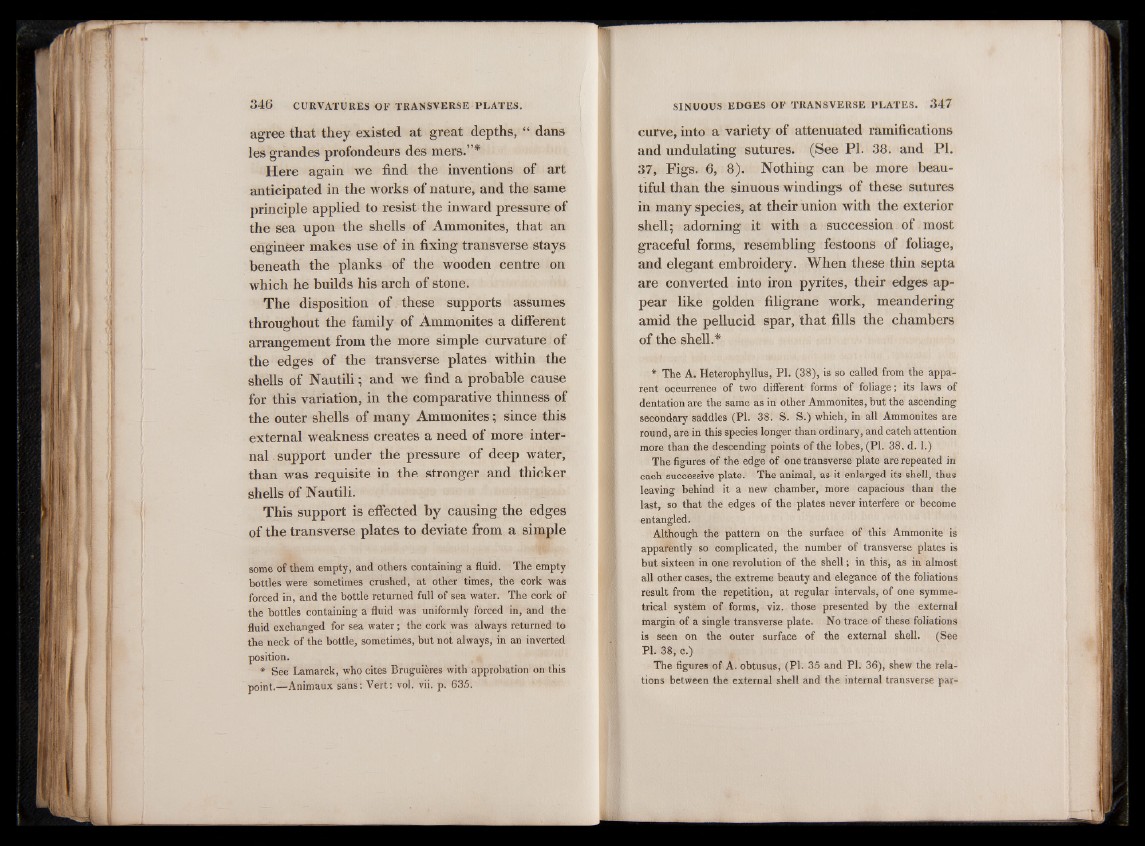
agree that they existed at great depths, “ dans
les grandes profondeurs des mers.”*
Here again we find the inventions of art
anticipated in the works of nature, and the same
principle applied to resist the inward pressure of
the sea upon the shells of Ammonites, that an
engineer makes use of in fixing transverse stays
beneath the planks of the wooden centre on
which he builds his arch of stone.
The disposition of these supports assumes
throughout the family of Ammonites a different
arrangement from the more simple curvature of
the edges of the transverse plates within the
shells of Nautili; and we find a probable cause
for this variation, in the comparative thinness of
the outer shells of many Ammonites; since this
external weakness creates a need of more internal
support under the pressure of deep water,
than was requisite in the stronger and thicker
shells of Nautili.
This support is effected by causing the edges
of the transverse plates to deviate from a simple
some of them empty, and others containing a fluid. The empty
bottles were sometimes crushed, at other times, the cork was
forced in, and the bottle returned full of sea water. The cork of
the bottles containing a fluid was uniformly forced in, and the
fluid exchanged for sea water; the cork was always returned to
the neck of the bottle, sometimes, but not always, in an inverted
position.
* See Lamarck, who cites Bruguieres with approbation on this
point.—Animaux sans: Vert: vol. vii. p. 635.
curve, into a variety of attenuated ramifications
and undulating sutures. (See PI. 38. and PI.
3 7 , Figs. 6 , 8 ). Nothing can be more beautiful
than the sinuous windings of these sutures
in many species, at their union with the exterior
shell; adorning it with a succession of most
graceful forms, resembling festoons of foliage,
and elegant embroidery. When these thin septa
are converted into iron pyrites, their edges appear
like golden filigrane work, meandering
amid the pellucid spar, that fills the chambers
of the shell.*
* The A. Heterophyllus, PI. (38), is so called from the apparent
occurrence of two different forms of foliage; its laws of
dentation are the same as in other Ammonites, but the ascending
secondary saddles (PI. 38. S. S.) which, in all Ammonites are
round, are in this species longer than ordinary, and catch attention
more than the descending points of the lobes, (PI. 38. d. 1.)
The figures of the edge of one transverse plate are repeated in
each successive plate. The animal, as it enlarged its shell, thus
leaving behind it a new chamber, more capacious than the
last, so that the edges of the plates never interfere or become
entangled.
Although the pattern on the surface of this Ammonite is
apparently so complicated, the number of transverse plates is
but sixteen in one revolution of the shell; in this, as in almost
all other cases, the extreme beauty and elegance of the foliations
result from the repetition, at regular intervals, of one symmetrical
system of forms, viz. those presented by the external
margin of a single transverse plate. No trace of these foliations
is seen on the outer surface of the external shell. (See
Pi. 38, c.)
The figures of A. obtusus, (PI. 35 and PI. 36), shew the relations
between the external shell and the internal transverse par